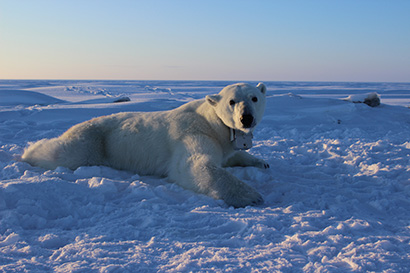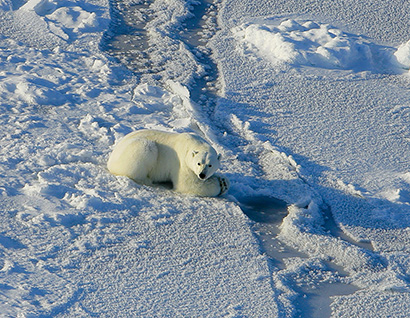A new study finds polar bears in the wild have higher metabolic rates than previously thought, and as climate change alters their environment a growing number of bears are unable to catch enough prey to meet their energy needs.
The study, published February 2 in Science, reveals the physiological mechanisms behind observed declines in polar bear populations, said first author Anthony Pagano, a Ph.D. candidate at UC Santa Cruz.
"We've been documenting declines in polar bear survival rates, body condition, and population numbers over the past decade," he said. "This study identifies the mechanisms that are driving those declines by looking at the actual energy needs of polar bears and how often they're able to catch seals."
Pagano, who is also a wildlife biologist with the U.S. Geological Survey (USGS), conducted the study as part of his Ph.D. thesis research at UC Santa Cruz, where he has been working with coauthors Terrie Williams and Daniel Costa, both professors of ecology and evolutionary biology.
The researchers monitored the behavior, hunting success, and metabolic rates of adult female polar bears without cubs as they hunted for prey on the sea ice of the Beaufort Sea in the spring. High-tech collars on the bears recorded video, locations, and activity levels over a period of eight to 11 days, while metabolic tracers enabled the team to determine how much energy the bears expended.
The field metabolic rates they measured averaged more than 50 percent higher than previous studies had predicted. Five of the nine bears in the study lost body mass, meaning they weren't catching enough fat-rich marine mammal prey to meet their energy demands.
"This was at the start of the period from April through July when polar bears catch most of their prey and put on most of the body fat they need to sustain them throughout the year," Pagano said.
Climate change
Climate change is having dramatic effects on the Arctic sea ice, forcing polar bears to move greater distances and making it harder for them to catch prey. In the Beaufort Sea, sea ice starts to retreat away from the continental shelf in July, and most of the bears move north on the ice as it retreats. As the Arctic warms and more sea ice melts, the bears are having to move much greater distances than previously. This causes them to expend more energy during the summer, when they are fasting until the ice returns to the continental shelf in the fall.
In other areas, such as Hudson Bay, most bears move onto land when the sea ice retreats. There, Arctic warming means the sea ice is breaking up earlier in the summer and returning later in the fall, forcing bears to spend more time on land.
"Either way, it's an issue of how much fat they can put on before the ice starts to break up, and then how much energy are they having to expend," Pagano said.
Previous studies had tried to estimate polar bear metabolic rates and energy expenditures based on some assumptions about their behavior and physiology. For example, since polar bears are primarily "sit and wait" hunters, it was thought this would minimize their energy expenditure during hunting. Researchers also speculated that polar bears could lower their metabolic rate to save energy if they were not successful catching seals, Pagano said.
"We found that polar bears actually have much higher energy demands than predicted. They need to be catching a lot of seals," he said.
In the spring, polar bears are mostly preying on recently weaned ringed seals, which are more susceptible to being caught than adult seals. By the fall, the young seals are older and wiser, and polar bears are not able to catch as many. "It's thought that bears might catch a couple per month in the fall, compared to five to 10 per month in the spring and early summer," Pagano said.
Population decline
USGS researchers have been studying polar bears in the Beaufort Sea area since the 1980s. Their most recent population estimate indicates the polar bear population has declined by about 40 percent over the past decade. It has been difficult, however, for researchers to study the fundamental biology and behavior of polar bears in this very remote and harsh environment, Pagano said.
"We now have the technology to learn how they are moving on the ice, their activity patterns, and their energy needs, so we can better understand the implications of these changes we are seeing in the sea ice," he said.
In addition to Pagano, Williams, and Costa, the coauthors of the paper include USGS researchers George Durner, Karyn Rode, Todd Atwood, and Elizabeth Peacock; Stephen Atkinson of Dugald, Manitoba; and Megan Owen at the San Diego Zoo Institute for Conservation Research. This work was supported by the USGS Changing Arctic Ecosystems Initiative.




